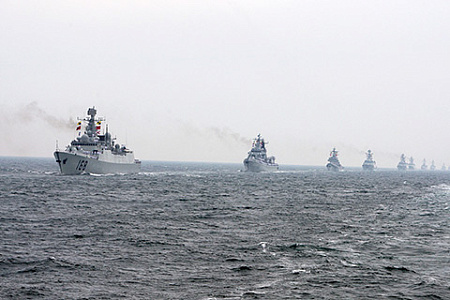Chinese Submarine Rescuers may turn into hunters
The command of the People's Liberation Army of China (PLA) pays close attention to improving the forms and methods of using the Navy in conditions of high intensity of hostilities and the use of non-standard approaches in the confrontation at sea. Chinese military experts are working on a theoretical justification and practical confirmation of the expansion of the tools of the PLA Navy support vessels and the assignment of tasks not peculiar to them before.
In wartime, the PLA Navy command can use the forces and means of logistics, which in peacetime are assigned the tasks of maintaining established material reserves and providing fleets with them. To achieve these goals, rescue teams have been formed in the fleets of the PLA Navy, which are equipped with rescue vessels – that is, special support vessels with equipment for performing search and rescue, ship-lifting and underwater technical work. They are divided into submarine rescue vessels, tugs, diving boats, ship-lifting and fire-fighting vessels.
The PLA Navy's rescue support vessels of Project 925 (type "Dajiang") are designed to assist ships, vessels and aircraft in distress, as well as to perform ship-lifting and underwater technical work. The vessel carries one or two deep-sea vehicles (DSRVs) equipped with a large crane. Three ships were built (861 – the Northern Fleet; 862 – the Eastern Fleet; 863 – the Southern Fleet).
Another type of vessel designed to rescue submarines is Project 926 (type "Dalao"). The PLA Navy has three vessels of this type in combat. The vessel is capable of both replenishing submarine supplies and rescuing submariners in distress. It is noteworthy that with a displacement of 9,500 tons, the vessel carries rescue cameras capable of performing rescue operations at depths up to 300 m, being able to save a maximum of 18 submariners for each dive.
One of the ships of Project 926 carries a DSRV deep-sea rescue vehicle imported from the UK (LR7), which is a development of an earlier version (LR5). The LR7 is also capable of rescuing a total of 18 submariners per dive, and the 25-ton DSRV can perform rescue operations at a depth of five hundred meters and continuously work underwater for four days. The remaining ships carry the successor DSRV Type 7103, developed by Harbin University of Engineering.
Chinese military experts recognize that along with the technical equipment of the vessels considered capable of rescuing submarines, the level of their combat capabilities should also increase. This is due to the fact that the situation in the near–sea zone and remote marine areas may not change in favor of China in the event of an increase in conflict potential - for example, in the event of a conflict in Taiwan.
On the other hand, the likely opponents (USA, Japan, South Korea, Vietnam) traditionally do not consider submarine rescue vessels as combat units. Therefore, their use as warships can make it possible to take advantage of the effect of surprise to strike at the enemy.
As part of the modernization of submarine rescue vessels, Chinese engineers are carrying out a set of targeted measures to improve their technical equipment, which in the future will expand the range of tasks they solve. Thus, in the interests of improving interaction with submarines, new radar stations (radars) of national design have already been installed on ships, capable of increasing the efficiency of sounding the seabed by 15% to search for submarines and communicate with the crew. On the other hand, the new equipment makes it possible to increase interaction with reconnaissance ships of the Yuanwan-3 type to solve reconnaissance tasks.
A fundamentally new aspect of the re-equipment of the PLA Navy submarine rescue vessels is the possibility of using them to solve anti-submarine defense tasks. Launchers for deep-sea vehicles can be upgraded to launch Chinese-made torpedoes of the Yu family. The potential equipping of ships with autonomous uninhabited vehicles will allow the crew to safely deal with sea mines.
The PLA command is considering arming the ships in question with a naval version of the Hongqi-10 (HQ-10) short-range air defense systems, which can attack enemy naval ships and ground targets. In addition, the Yingji-83 anti-ship missile (YJ-83) and the Yingji-91 cruise missile (YJ-91) can become the main armament of ships for self-defense. Both missiles have high range and accuracy and can deliver defensive strikes against enemy targets at long range.
Thus, the PLA continues to have a significant number of naval submarine rescue vessels in service. Based on the requirements of the military-political situation, there is a continuous technical modernization of these vessels, which is aimed at a comprehensive increase in their combat capabilities. After the modernization, the vessels will probably be able to perform tasks typical of warships of the main classes. However, this very possibility will be hidden from outside observers, since solving combat missions for rescue vessels is an unusual task.
Vasily Ivanov
Vasily Ivanovich Ivanov is a journalist.


